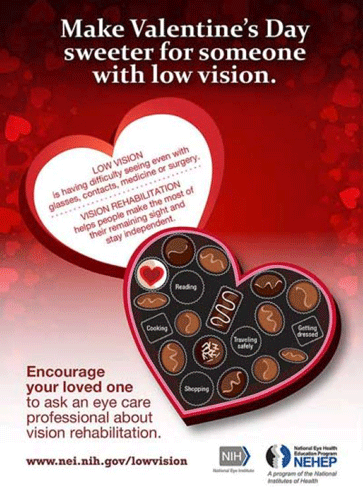It’s not all chocolate and flowers. There’s a vision connection to the man for whom Valentine’s Day is named. Writings about St. Valentine of Rome give accounts of two instances in which he restored sight to the blind. The first was the daughter of a judge who had arrested Valentine. The second was the daughter of his jailer, just before Valentine’s execution. Is it coincidence, then, that February is Low Vision Awareness Month?
 The Glaucoma Research Foundation notes that 4.2 million Americans over age 40 are visually impaired, and of those, 3 million have low vision. They project that by 2030, with the population aging, those numbers will grow to 7.2 million visually impaired, and 5 million with low vision. They cite the leading causes of vision loss in older adults as age related macular degeneration, diabetic retinopathy, cataract, and glaucoma. Among younger people, vision loss is most often caused by inherited eye conditions, infectious and autoimmune eye diseases, or trauma. For people with low vision, maximizing their remaining sight is key to helping them continue to live safe, productive, and rewarding lives.
The Glaucoma Research Foundation notes that 4.2 million Americans over age 40 are visually impaired, and of those, 3 million have low vision. They project that by 2030, with the population aging, those numbers will grow to 7.2 million visually impaired, and 5 million with low vision. They cite the leading causes of vision loss in older adults as age related macular degeneration, diabetic retinopathy, cataract, and glaucoma. Among younger people, vision loss is most often caused by inherited eye conditions, infectious and autoimmune eye diseases, or trauma. For people with low vision, maximizing their remaining sight is key to helping them continue to live safe, productive, and rewarding lives.Low vision is an uncorrectable vision loss that impairs one’s ability to function normally and perform the activities needed to live independently. The actual visual acuity causing this disability varies from person to person. According to the World Health Organization (WHO), a range of visual acuity from 20/70 to 20/400 is considered moderate visual impairment or low vision. While advances in surgery and medication can help in many cases, coping with low vision becomes the new normal for many.
During Low Vision Awareness Month, the National Eye Institute (NEI) is highlighting new technologies and tools in the works to help the millions of Americans living with low vision or blindness. One of those technologies is an interactive co-robotic cane that uses a 3-D camera to guide the user to a particular location. Another is a glove that uses a camera and speech recognition to guide the user to small objects such as a door handle, mug or bowl. Then, there’s a smartphone app for crossing the street that gives auditory prompts to help users identify the safest crossing location and stay within the crosswalk. There’s also a camera input-output system that provides real-time audio feedback as the user explores an object by turning it around and touching it. And for those with peripheral field loss, there’s a periscope using lenses constructed of many adjacent one-millimeter wide prisms that expand the visual field while preserving central vision. The developer of the periscope, Eli Peli, O.D., of Schepens Eye Research Institute, Boston, wants to work with optical labs to manufacture a periscope that can be mounted into a pair of glasses.
While these innovations and others can help those with low vision with everyday tasks and quality of life, as ECPs, we need to help raise low vision awareness. The NEI has a great deal of information, resources and materials available at https://nei.nih.gov/lowvision. And an excellent learning resource is our CE, An Introduction to Low Vision, at 2020mag.com/ce. You just may be able to make someone’s Valentine’s Day a little sweeter.













